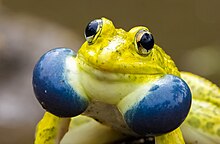
Back বামুণ ভেকুলা Assamese Тигрова жаба Bulgarian भारतीय मेघा Bihari কোলা ব্যাঙ Bengali/Bangla Hoplobatrachus tigerinus Catalan Hoplobatrachus tigerinus CEB Skokan tygrovitý Czech Asiatischer Ochsenfrosch German Tigrostria rano Esperanto Hoplobatrachus tigerinus Spanish
| Hoplobatrachus tigerinus | |
|---|---|

| |
| Breeding male | |
| Scientific classification | |
| Domain: | Eukaryota |
| Kingdom: | Animalia |
| Phylum: | Chordata |
| Class: | Amphibia |
| Order: | Anura |
| Family: | Dicroglossidae |
| Genus: | Hoplobatrachus |
| Species: | H. tigerinus
|
| Binomial name | |
| Hoplobatrachus tigerinus (Daudin, 1802)
| |
| Synonyms[3] | |
| |
Hoplobatrachus tigerinus, commonly known as the Indian bullfrog, is a large species of fork-tongued frog found in South and Southeast Asia. A relatively large frog, it is normally green in color, although physiological traits vary between populations. Sexual dimorphism exists between males and females. Outside of its native range, H. tigerinus is a rapidly-spreading invasive species. Both adults and tadpoles can severely damage the populations of other frog species. Typically, Indian bullfrogs dwell in wetland environments. Research has been conducted on their ability to control mosquitos.
- ^ Padhye, A.; Manamendra-Arachchi, K.; de Silva, A.; Dutta, S.; Kumar Shrestha, T.; Bordoloi, S.; Papenfuss, T.; Anderson, S.; Kuzmin, S.; Khan, M.S.; Nussbaum, R. (2008). "Hoplobatrachus tigerinus". IUCN Red List of Threatened Species. 2008: e.T58301A11760496. doi:10.2305/IUCN.UK.2008.RLTS.T58301A11760496.en. Retrieved 20 November 2021.
- ^ "Appendices | CITES". cites.org. Retrieved 2022-01-14.
- ^ "Hoplobatrachus tigerinus (Daudin, 1802)". Global Biodiversity Information Facility. Retrieved 12 December 2024.
